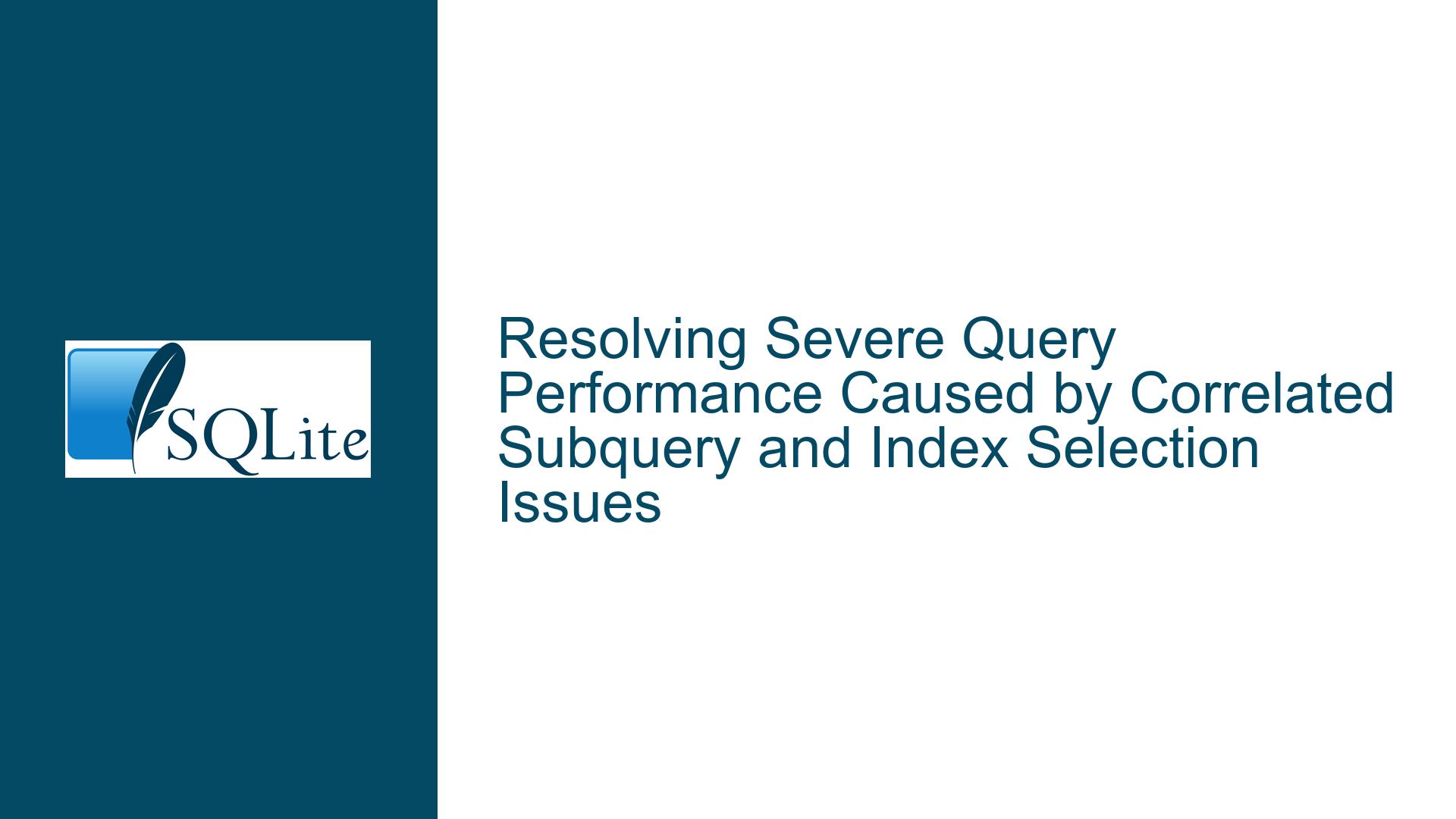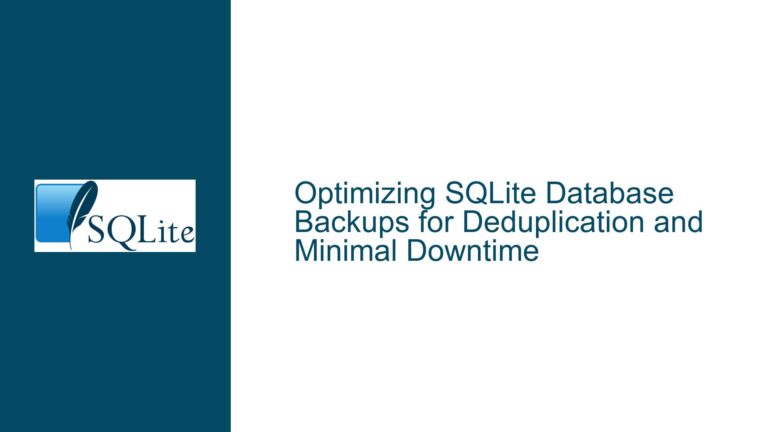Resolving Severe Query Performance Caused by Correlated Subquery and Index Selection Issues
Dynamic Main Row Selection with Correlated Subquery Leading to Exponential Performance Degradation
Issue Overview
The core problem revolves around a SQLite query designed to select one representative row per group from a large table (t1), dynamically determined by evaluating scoring criteria from a secondary table (t2). This query suffers from sporadic but severe performance degradation, escalating from milliseconds to tens of seconds under specific conditions. The root of the issue lies in the interaction between three critical components:
Correlated Subquery Execution: The query uses a correlated subquery to determine the "main row" for each group. This subquery is executed repeatedly—once for every row processed in the outer query. The subquery involves joins between
t2(aliased ast3) andt1, filtering on columns likec3,c4,c5,c2,group_id, andc8, followed by anORDER BY c9 DESC, c10to select the highest-scoring row. This structure forces SQLite to re-evaluate the subquery for every candidate row in the outer loop, leading to O(N²) complexity.Index Misuse or Absence: The subquery’s performance hinges on efficient index usage. While an existing index
i1ont2 (group_id, c8, c2, c9, c1)improves performance when explicitly forced (INDEXED BY i1), this approach is brittle. The query planner may ignore optimal indexes due to outdated statistics, schema changes, or conflicting filtering conditions.Outdated Query Planner Statistics: SQLite relies on stored statistics (collected via
ANALYZE) to choose execution plans. When large datasets are added in bulk (e.g., initial app setup with thousands of rows), the planner’s decisions become suboptimal because statistics no longer reflect the true data distribution. This is exacerbated by the dynamic nature of the "main row" selection, which depends on real-time scoring rather than static flags.
Potential Causes of Degraded Performance
Correlated Subquery Overhead
- Mechanism: The subquery
t1.c1 = (SELECT ...)is correlated to the outert2table throught3.c2 IS t2.c2,t3.group_id = t2.group_id, andt3.c8 = t2.c8. For each row in the outer query, SQLite must execute the subquery, joiningt3(a copy oft2) witht1, applying filters, sorting, and selecting the top result. - Impact: With 50k+ rows in
t1, even minor inefficiencies in the subquery (e.g., full scans instead of index seeks) compound exponentially. A 1ms subquery per row becomes 50 seconds for 50k rows.
- Mechanism: The subquery
Inefficient Index Utilization
- Index Design: The existing index
i1ont2includesgroup_id, c8, c2, c9, c1, but the subquery’sWHEREclause filters ont3.c2,group_id,c8, andt1.c3, c4, c5. Missing composite indexes covering these columns or misaligned index column order can force full scans. - Query Planner Misjudgment: Without up-to-date statistics, the planner may underestimate the selectivity of filters (e.g.,
t1.c3 = 0), leading to suboptimal index choices. Forcing an index (INDEXED BY) masks the problem but does not resolve underlying planner inaccuracies.
- Index Design: The existing index
Statistics and Data Volatility
- ANALYZE Neglect: If
ANALYZEhas not been run after bulk data changes, the planner uses default or stale statistics, causing incorrect assumptions about join cardinality and filter selectivity. - Data Skew: Scenarios like an initially empty
t1followed by rapid insertion of thousands of rows create skewed distributions. The planner’s default heuristics (e.g., assuming uniform distribution forc3,c4,c5) become invalid, leading to catastrophic plan choices.
- ANALYZE Neglect: If
Troubleshooting Steps, Solutions, and Fixes
Step 1: Update Query Planner Statistics
- Action: Execute
ANALYZEto refresh statistics. This generates or updates thesqlite_stat1table, which stores histogram data for indexes and tables.ANALYZE; - Rationale: Modern SQLite versions (3.33.0+) use histograms for better selectivity estimates. Updated statistics help the planner recognize that
t1.c3 = 0,c4 = 0, andc5 = 0are highly selective (if true), favoring index usage.
Step 2: Analyze Query Execution Plans
- Action: Use
EXPLAIN QUERY PLANto compare plans with and without forced indexes.EXPLAIN QUERY PLAN SELECT ... [original query]; - Key Observations:
- Check if the subquery uses an index for
t3(look forSEARCH t2 AS t3 USING INDEX ...). - Verify join order: The planner should prioritize indexed joins over full scans.
- Identify nested loops vs. hash joins. Correlated subqueries often result in nested loops, which are inefficient at scale.
- Check if the subquery uses an index for
Step 3: Optimize Indexing Strategy
- Composite Index for
t1: Create an index coveringc3,c4,c5, andc1to accelerate the subquery’sWHEREclause:CREATE INDEX idx_t1_filter ON t1(c3, c4, c5, c1); - Revised Index for
t2: Adjusti1to match the subquery’s join and filter order:CREATE INDEX idx_t2_main_row ON t2(group_id, c8, c2, c9 DESC, c10 DESC, c1);This index aligns with the
WHERE t3.group_id = t2.group_id AND t3.c8 = t2.c8 AND t3.c2 IS t2.c2andORDER BY c9 DESC, c10clauses, allowing a single index seek per subquery.
Step 4: Rewrite the Correlated Subquery Using CTEs or Window Functions
- Problem: The correlated subquery forces repeated execution. Rewrite it using a Common Table Expression (CTE) to compute all "main rows" upfront.
- CTE-Based Approach:
WITH RankedGroups AS ( SELECT t1._id, t1.c1, t2.group_id, t2.c8, t2.c2, ROW_NUMBER() OVER ( PARTITION BY t2.group_id, t2.c8, t2.c2 ORDER BY t1.c9 DESC, t1.c10 DESC ) AS rank FROM t1 JOIN t2 ON t1.c1 = t2.c1 WHERE t1.c3 = 0 AND t1.c4 = 0 AND t1.c5 = 0 ) SELECT [various columns] FROM ( SELECT _id FROM RankedGroups WHERE rank = 1 AND ... [additional filters] ORDER BY c10 DESC, _id DESC LIMIT 225 ) LEFT JOIN ... [remaining joins]; - Advantages:
- The
ROW_NUMBER()window function computes ranks in a single pass, eliminating O(N²) subquery overhead. - Partitioning by
group_id,c8, andc2mirrors the original subquery’s grouping logic.
- The
Step 5: Adjust Database Configuration
- Increase Cache Size: Set
PRAGMA cache_size = -kibibytes;to allocate more memory for caching pages. For example,PRAGMA cache_size = -10000;reserves ~10MB. - Enable Memory-Mapped I/O: If using multiple connections, configure
PRAGMA mmap_size = ...;to reduce I/O contention.
Step 6: Monitor and Optimize Incrementally
- Profile with
sqlite3_stmtExtension: Usesqlite3_stmt_status()to track subquery executions and page cache hits. - Regular Maintenance: Schedule
PRAGMA optimize;after significant data changes to automate index rebuilds and statistics updates.
Final Recommendations
- Replace correlated subqueries with set-based operations (CTEs, window functions).
- Ensure indexes are tailored to both filter and order-by clauses.
- Combine
ANALYZEwith proactive statistics maintenance. - Test changes incrementally using real-world data distributions to validate planner decisions.
By systematically addressing correlated query execution, index alignment, and planner statistics, the sporadic performance degradation can be resolved, achieving consistent sub-100ms response times.






